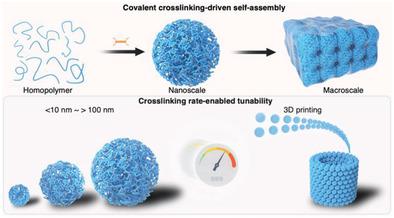当前位置:
X-MOL 学术
›
Adv. Mater.
›
论文详情
Our official English website, www.x-mol.net, welcomes your
feedback! (Note: you will need to create a separate account there.)
Controlled Covalent Self-Assembly of a Homopolymer for Multiscale Materials Engineering
Advanced Materials ( IF 27.4 ) Pub Date : 2022-07-30 , DOI: 10.1002/adma.202109701 Xiangyang Bai 1 , Qingxue Sun 1 , Hao Cui 1 , Luis P B Guerzoni 2 , Stefan Wuttke 3, 4 , Fabian Kiessling 1 , Laura De Laporte 2, 5, 6 , Twan Lammers 1, 7, 8 , Yang Shi 1
Advanced Materials ( IF 27.4 ) Pub Date : 2022-07-30 , DOI: 10.1002/adma.202109701 Xiangyang Bai 1 , Qingxue Sun 1 , Hao Cui 1 , Luis P B Guerzoni 2 , Stefan Wuttke 3, 4 , Fabian Kiessling 1 , Laura De Laporte 2, 5, 6 , Twan Lammers 1, 7, 8 , Yang Shi 1
Affiliation

|
Polymer self-assembly is a crucial process in materials engineering. Currently, almost all polymer self-assembly is limited to non-covalent bonding methods, even though these methods have drawbacks as they require complicated synthesis techniques and produce relatively unstable structures. Here, a novel mechanism of covalent polymer self-assembly is discovered and employed to address drawbacks of non-covalent polymer self-assembly. A simple ketone homopolymer is found to self-assemble into nano- to macroscale hydrogels during covalent crosslinking. In contrast to non-covalent self-assembly, the covalent self-assembly is independent of and unaffected by solvent conditions (e.g., polarity and ionic strength) and does not require additional agents, e.g., organic solvents and surfactants. The covalent polymer self-assembly is subjected to a new mechanism of control by tuning the covalent crosslinking rate. This leads to nanogels with an unprecedented and tightly controlled range of dimensions from less than 10 nm to above 100 nm. Moreover, the crosslinking rate also regulates the assembly behavior of microgels fabricated by microfluidics. The microgels self-assemble into granular fibers, which is 3D printed into stable porous scaffolds. The novel covalent polymer assembly method has enormous potential to revolutionize multiscale materials fabrication for applications in drug delivery, tissue engineering, and many other fields.
中文翻译:

用于多尺度材料工程的均聚物的可控共价自组装
聚合物自组装是材料工程中的关键过程。目前,几乎所有的聚合物自组装都局限于非共价键合方法,尽管这些方法存在缺点,因为它们需要复杂的合成技术并产生相对不稳定的结构。在这里,发现了一种新的共价聚合物自组装机制,并用于解决非共价聚合物自组装的缺点。发现一种简单的酮均聚物在共价交联过程中自组装成纳米到宏观尺度的水凝胶。与非共价自组装相反,共价自组装独立于溶剂条件(例如极性和离子强度)并且不受其影响,并且不需要额外的试剂,例如有机溶剂和表面活性剂。通过调整共价交联速率,共价聚合物自组装受到新的控制机制。这导致纳米凝胶具有前所未有的和严格控制的尺寸范围,从小于 10 nm 到高于 100 nm。此外,交联速率还调节由微流体制造的微凝胶的组装行为。微凝胶自组装成颗粒状纤维,然后 3D 打印成稳定的多孔支架。新型共价聚合物组装方法具有巨大的潜力,可以彻底改变多尺度材料制造,应用于药物输送、组织工程和许多其他领域。交联速率还调节由微流体制造的微凝胶的组装行为。微凝胶自组装成颗粒状纤维,然后 3D 打印成稳定的多孔支架。新型共价聚合物组装方法具有巨大的潜力,可以彻底改变多尺度材料制造,应用于药物输送、组织工程和许多其他领域。交联速率还调节由微流体制造的微凝胶的组装行为。微凝胶自组装成颗粒状纤维,然后 3D 打印成稳定的多孔支架。新型共价聚合物组装方法具有巨大的潜力,可以彻底改变多尺度材料制造,应用于药物输送、组织工程和许多其他领域。
更新日期:2022-07-30
中文翻译:

用于多尺度材料工程的均聚物的可控共价自组装
聚合物自组装是材料工程中的关键过程。目前,几乎所有的聚合物自组装都局限于非共价键合方法,尽管这些方法存在缺点,因为它们需要复杂的合成技术并产生相对不稳定的结构。在这里,发现了一种新的共价聚合物自组装机制,并用于解决非共价聚合物自组装的缺点。发现一种简单的酮均聚物在共价交联过程中自组装成纳米到宏观尺度的水凝胶。与非共价自组装相反,共价自组装独立于溶剂条件(例如极性和离子强度)并且不受其影响,并且不需要额外的试剂,例如有机溶剂和表面活性剂。通过调整共价交联速率,共价聚合物自组装受到新的控制机制。这导致纳米凝胶具有前所未有的和严格控制的尺寸范围,从小于 10 nm 到高于 100 nm。此外,交联速率还调节由微流体制造的微凝胶的组装行为。微凝胶自组装成颗粒状纤维,然后 3D 打印成稳定的多孔支架。新型共价聚合物组装方法具有巨大的潜力,可以彻底改变多尺度材料制造,应用于药物输送、组织工程和许多其他领域。交联速率还调节由微流体制造的微凝胶的组装行为。微凝胶自组装成颗粒状纤维,然后 3D 打印成稳定的多孔支架。新型共价聚合物组装方法具有巨大的潜力,可以彻底改变多尺度材料制造,应用于药物输送、组织工程和许多其他领域。交联速率还调节由微流体制造的微凝胶的组装行为。微凝胶自组装成颗粒状纤维,然后 3D 打印成稳定的多孔支架。新型共价聚合物组装方法具有巨大的潜力,可以彻底改变多尺度材料制造,应用于药物输送、组织工程和许多其他领域。











































 京公网安备 11010802027423号
京公网安备 11010802027423号